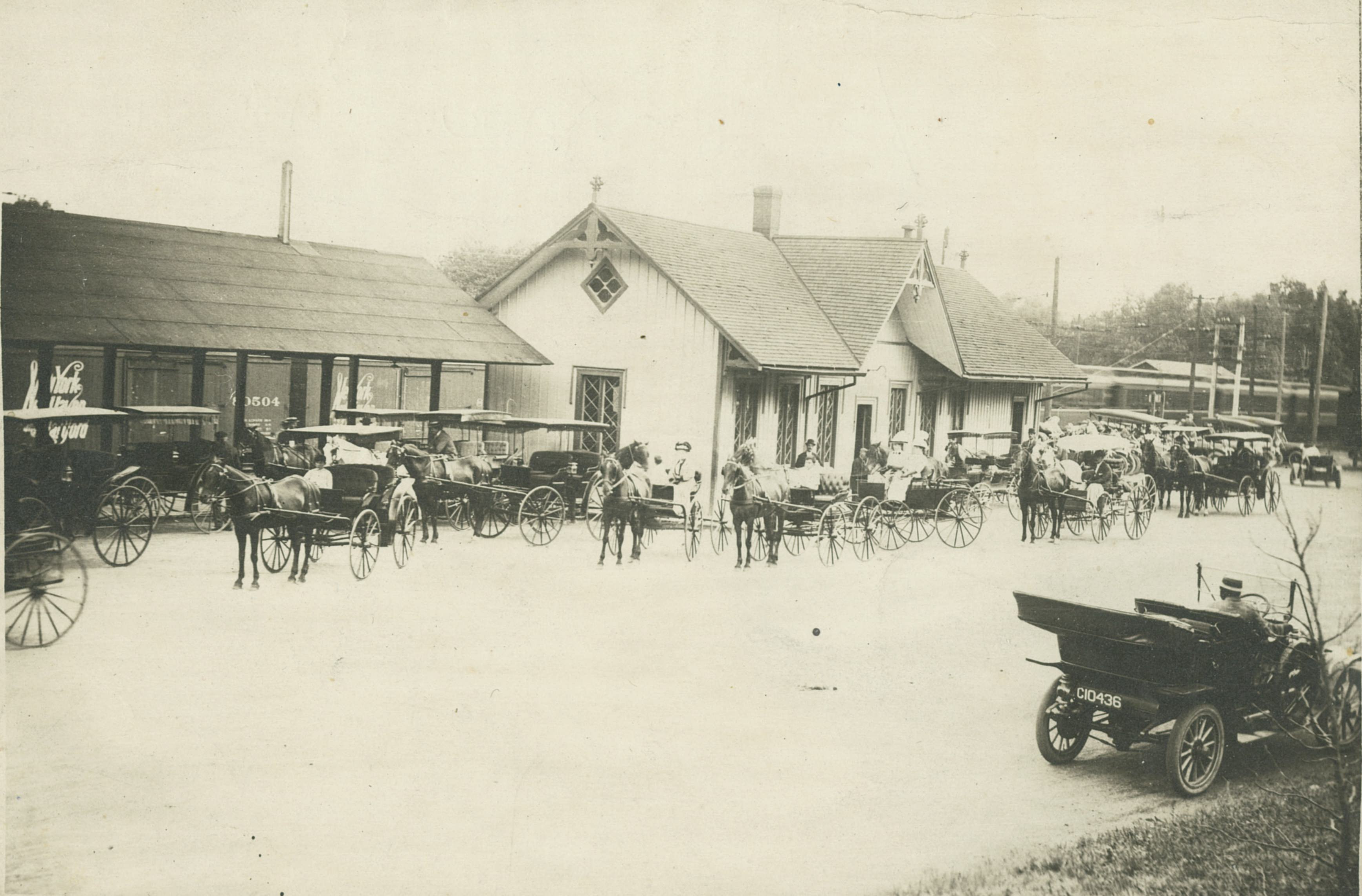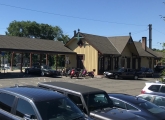198 Elm St.
The New Canaan Station, located at 198 Elm Street, has been called many names since its founding, including “The Canaan Union Station,” “New Canaan Railroad,” and “The Next Station to Heaven.” Its history dates back to the mid-1800s as New Canaanites wished to expand their prominent shoe manufacturing industry and looked to a railroad. Other towns such as Norwalk and Stamford had installed train lines and were experiencing an increase in wealth. In 1867, construction began for a gothic-revival style train station, a roundhouse, and a freight station that would be able to ship New Canaan’s commodities across Connecticut and further. The freight station was built directly across from the train station. The roundhouse was located most likely in the parking lot of 21 Grove St.( the current location of Weed & Duryea.) New Canaan citizens raised approximately $264,000 through the sale of “rolling stock.” It cost almost $30,000 per mile for the construction, but at its completion boasted 8 miles of transportation.
The train station opened on June 24th, 1868. The first train ran an excursion trip on July 4th to showcase the line. For only 85 cents, passengers could ride through and stop at New Hope (Glenbrook), Springdale, Riverside, Tallmadge Hill, and New Canaan. Riverside later became Woodway and served The Woodway Country Club. In 1868, the station saw approximately 100 passengers per day. The original train schedule was three trains per day in each direction with a special “late” train on Saturdays to Stamford at 7:30. The railcars followed a specific style with a single car mounted on the front of a small upright steam engine, while inside wooden parallel benches were arranged facing each other. The engines remained steam-powered until 1898 when they were replaced with electric.
The first president of the newly established New Canaan Railroad Company and one of the first commuters was Dr. Samuel St. John (He was mentioned in a previous Then & Now article on the second Congregational House). He was an accomplished lawyer, geologist, chemist, and professor at the College of Physicians and Surgeons in New York. The line was operated by the New Canaan Railroad Company until December 31st, 1878 when it suffered a profit loss.
The train station seems to have been in a constant state of disrepair. In the station’s 154 years, it was often on the verge of bankruptcy or completely bankrupt and needed regular assistance. Even in the days of horse and buggies the station had parking lot issues. Double parking was common; New Canaan residents knew that the parking lot was always busy.
In 1887, the local branch became part of the Stamford and New Canaan Railroad Company in a ninety-nine-year lease with New Haven. By 1890, the line had been absorbed by New Haven for $100,000. Because of the constant state of deterioration, the freight station was demolished by The Public Works Department in 1895. A new and updated freight station was built but later also demolished in the 1960s. In 1904, hoping to gain more profit, The New Canaan “express,” a steam-powered engine, made its first run to Stamford. The train carried 75 people, had five stops, including one in Old Greenwich, and ended at Grand Central.
In 1908, a train running late sped into the roundhouse causing a collision and damage to two rail cars. This accident crippled the station financially.
In 1970, Isodore Goodman bought the financially-strapped train station. His plan was to use federal funds to convert the station into low-cost housing units. While Goodman sought funding, Conrail purchased a new type of railcar for The New Haven Line, and New Canaan’s platforms needed to be adjusted to meet the new height of the doors on the new rail cars. Steel access stairways were installed to reach this new height. The concrete platforms, for now, remained at their same height. Because of related construction, without much announcement to commuters, no trains came on Tuesday, June 12th, 1974. Lots of people were stranded on the platforms without transportation. Things seemed to only get worse because from 1977 to 1982, the concrete platforms deteriorated and became rapidly unsafe. The concrete was simply, “falling off like ash, crumbling in your hand, ” retorted Charles Morton, the First Selectman in 1982. New Canaan citizens raised $28,500 for continuous repairs, but even with the repairs, the general attitude was one of disappointment and defeat with the maintenance of the train station.
Renovations were far from over as ownership changed once again to Ross Grannan and A. Paul Ramunni in 1984. These men recognized the historic potential and wanted to allocate more money for tourism and the installation of The New Canaan Railroad Museum. They began construction in 1996 with a general overhaul. During this renovation, they uncovered seventeen different layers of paint on the station house. After much debate, it was finally decided to paint the station a classic maroon shade that many other historic buildings shared.
Finally in 1998, the station was completely raised to meet the new height of the railcars and to bring it into compliance with the American with Disabilities Act in 1999. The last of the changes was the 2010 closure of the ticket window after 142 years of operation.
The New Canaan Train Station has been featured in the illustrator Charles Saxon’s 1959 cover of the New Yorker, the set design of The Town Player’s 1960 smash hit, “Next to Heaven,” and on multiple landmark ornaments.
“New Canaan Now & Then” is presented in partnership with the New Canaan Museum & Historical Society.




What a fantastic article! It’s wonderful that Ross Grannan and A. Paul Ramunni recognized both the historic and financial potential of preserving the train station in its original location, while bringing it up to (then) current standards for generations of others to use, especially after the developer, Goodman, wanted to use government funds to turn the space into low-income housing.
Imagine if we hadn’t had the train in town for the last 35+ years.
Before 1910 for several years trolley cars and their operators from Stamford were used as the rail line waited for the arrival of the first electric train cars for the line. Beyond the freight house along the track there was a white feed storage building as well. Back in the early days the train only ran until about 9PM compared to 1:15 am today.
Great article. I’d add one other historical note, and that is a train wreck in 1976 (my Dad was on that train). Headline from The New York Times the next day “Woman Is Killed and 24 Are Hurt in Train. Crash in New Canaan.”
https://www.nytimes.com/1976/07/14/archives/woman-is-killed-and-24-are-hurt-in-train-crash-in-new-canaan.html